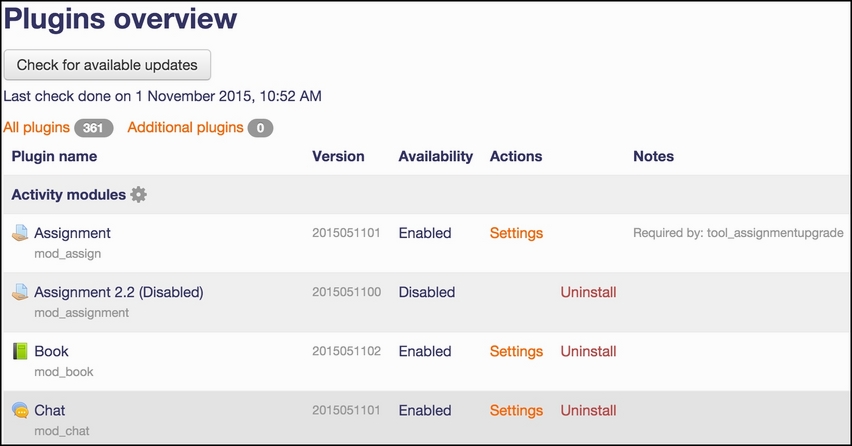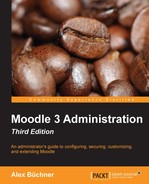Your system is now fully operational and has the look and feel to reflect the branding of your organization. As with all the complex web-based applications, there are a significant number of configuration activities that can be carried out to bring Moodle in line with your organization's needs and requirements.
One of the many strengths of Moodle is its pluggable architecture. Moodle supports a wide range of plugins, which will be covered in this chapter.
- Module plugins: These cover the core functionality available in a course, a front page, dashboard, and user profile pages. These include Activity modules, Blocks, and Filters.
- Repositories: Repositories allow the incorporating of data into Moodle, either from internal sources or external sites.
- Portfolios: These are the opposite of repositories. Portfolios allow the exporting of content from Moodle to other applications or data storage.
- Miscellaneous plugins: These include Course formats, Question types and behaviors, Plagiarism prevention, Licenses, and Availability restrictions.
There are a number of additional plugin types that have been covered in other chapters, namely, Enrolments (Chapter 4, Course Management), Authentication (Chapter 5, User Management), Message outputs (Chapter 9, Moodle Configuration), logging and reports (Chapter 10, Moodle Logging and Reporting), Cache (Chapter 12 , Moodle Performance and Optimization), Admin tools (Chapter 14, Moodle Admin Tools), and web services (Chapter 15, Moodle Integration).
The second part of this chapter deals with the management of plugins. You will learn the following essentials about installing third-party add-ons:
- Good, bad, and ugly third-party add-ons: As externally developed software is not scrutinized by Moodle's quality assurance process, you will have to judge the trustworthiness of non-core add-ons. A checklist of criteria is provided to make this decision a bit easier.
- Popular third-party add-ons: There are well over 1,000 titles to choose from. We will discuss the most popular ones that will be relatively useful to you before outlining a couple of organizational decisions regarding plugins.
- Installing third-party add-ons: We will describe the installation of the Collapsed Topics format plugin via the admin interface, the manual installation process for the popular Configurable Reports and custom reports builder, and the installation of the Certificate module via Git and the command line.
- Upgrading and uninstalling third-party add-ons: Here, we will describe how to keep installed plugins up to date and how to remove them from your Moodle instance.
Let's start with an overview of plugins.
Moodle plugins are modules that provide some specific, usually ring-fenced functionality. You can access the plugins area via the Plugins menu that is shown in the following screenshot:

Install plugins lets you add third-party add-ons to your Moodle system. This is dealt with in the second part of this chapter. Plugins overview displays a list of all the installed plugins. The information shown for each plugin includes Plugin name, an internal Identifier, its Source (standard or extension), its Version (in the date format), its Availability (enabled or disabled), a link to the Settings plugin, an option to Uninstall the plugin, and some Notes (usually in the form of dependencies or errors). This table is useful to get a quick overview of what has been installed on your system and what functionality is available. You can also perform Check for available updates via the button at the top of the screen.

Some areas contain a significant number of plugins, for instance, authentication method and question type. Other categories only contain one or two plugins. The expectation is that more plugins will be developed in the future, either as part of the Moodle core or by third-party developers. This guarantees the extensibility of Moodle without the need to change the system itself. We will be dealing with third-party add-ons in detail in the second part of this chapter.
One type of plugin that we haven't mentioned yet is called local plugins. This is the recommended place for any customizations that do not fit in any of the plugin types that have already been mentioned. These customizations can be changed according to the existing functionalities or the introduction of new features. For more information on local plugins, check out the readme.txt file in the local directory. This is in the root directory of your Moodle installation (dirroot).
Now that we have dealt with the commonalities among plugins, let's have a look at the different types of plugins available in your Moodle platform, grouped according to module plugins, repositories, portfolios, and miscellaneous plugins.
